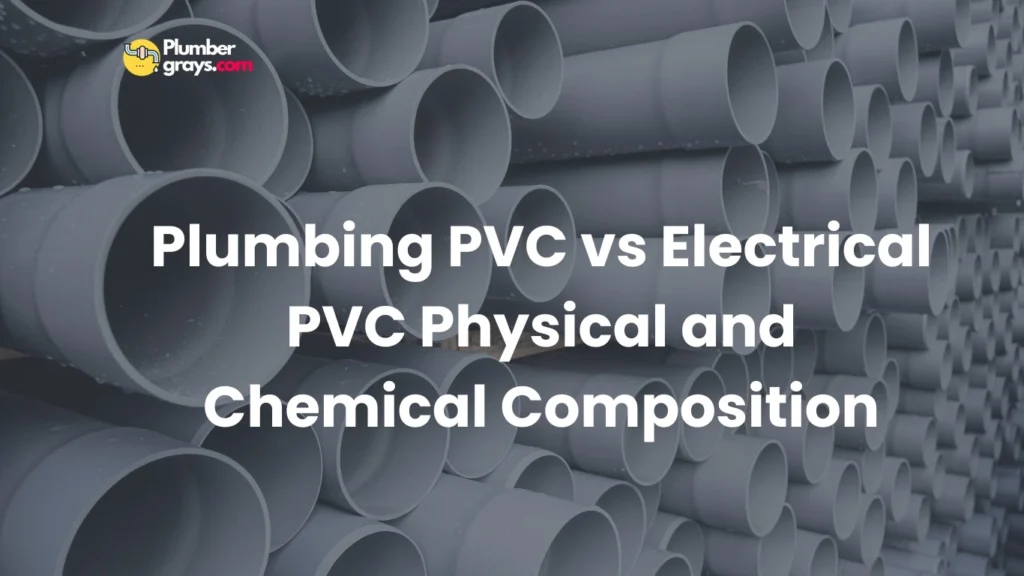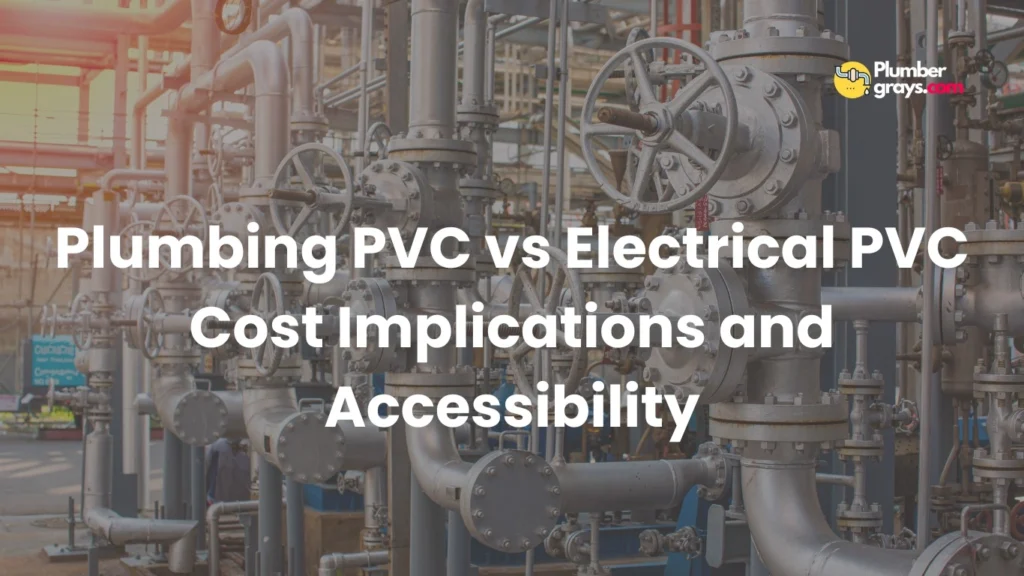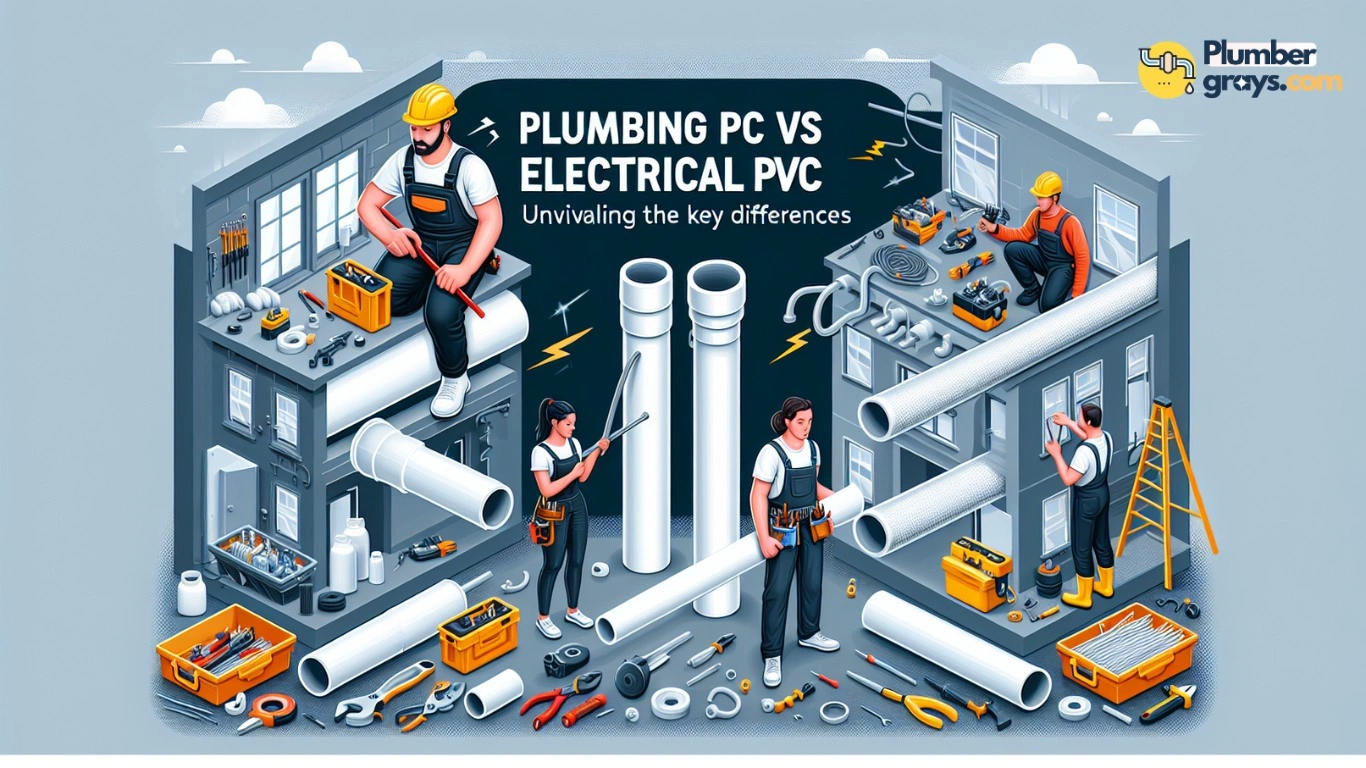Understanding the differences between PVC pipe types is critical, especially when distinguishing plumbing PVC from PVC pipe electrical. Plumbing PVC pipes, designed specifically as PVC plumbing pipes, are pressure tested to suit various applications and feature a thicker wall for enhanced durability. In contrast, electrical conduit PVC, which is not subjected to pressure testing, is tailored for safeguarding electrical systems.
The electrical conduit pipe is engineered to encase electrical wiring, boasting UV resistance and flared ends that facilitate seamless connectivity without additional couplers, making it an excellent choice for outdoor and exposed settings. Conversely, PVC pipe plumbing is crafted for efficient use in drain, water, and ventilation systems, identifiable by its white color which, unlike the UV-resistant gray PVC for electrical, is prone to UV degradation.
Physical and Chemical Composition

Exploring the physical differences in the composition of plumbing PVC and electrical PVC is vital to understanding their specific roles and requirements in their respective applications.
- Color and UV Resistance: The white plumbing pipe signals its limitation in UV resistance, prone to degradation under sunlight, while the gray hue of electrical conduit PVC indicates its UV-resistant nature, rendering it suitable for outdoor electrical installations.
- Wall Thickness and Pressure Testing: Plumbing PVC is renowned for its pressure resistance, boasting a thicker wall to ensure it can manage the high-pressure demands of PVC plumbing pipe systems. Electrical conduit PVC, on the other hand, is not designed for pressure resistance as its main role is to provide a protective casing for electrical wires, not to handle high internal pressure.
- Additives and Applications: Each type of PVC incorporates specific additives to meet their unique requirements; plumbing PVC is optimized for higher temperature and pressure ratings, vital for PVC pipe for plumbing, while electrical PVC contains additives that enhance UV hardness and safety features, aligning with the PVC meaning in electrical as a protective barrier.
Recognizing the distinctions between PVC vs conduit is essential for the correct selection and use of PVC in plumbing and electrical systems, ensuring optimal safety, efficiency, and system longevity.
Application and Utility
Grasping the unique applications and benefits of Plumbing PVC versus Electrical PVC is crucial for their optimal use in their respective domains. Comparisons like this one are essential to help you choose the right type based on specific requirements:
- Plumbing PVC Applications:
- Designed primarily for plumbing systems to carry air and water.
- Plumbing PVC pipe is commonly utilized in drain, water, and ventilation systems, prized for its robustness in managing the stress and pressure associated with fluid movement.
- Plumbing PVC requires solvent welds, complete with primer and glue for secure assembly, and is available in various pressure couplings to effectively maintain water pressure.
- Electrical PVC Utility:
- Serves as a protective housing for electrical wires or cables, preventing electrical accidents.
- PVC pipe for electrical wiring is designed with flared ends to facilitate easy connectivity without the need for additional couplers, streamlining wire pulling, grounding, and safeguarding against dust ingress.
- Electrical PVC is listed for electrical use and meets all code requirements, including compliance with UL, CSA, and NEC regulations, ensuring it upholds safety standards in electrical systems.
- Key Differences in Use:
- Plumbing PVC, due to its insufficient rigidity and inadequate UV radiation resistance, is a code violation if used for electrical applications, highlighting the importance of using the correct materials for each field.
- Electrical conduit PVC, which is not designed for high-pressure scenarios, should not be substituted for standard PVC in water lines or high-pressure air systems, as this could lead to a dangerous conduit vs PVC mismatch.
- For each distinct application, specific fittings are required; for instance, PVC conduit vs PVC pipe highlights that plumbing fittings and pipes are incompatible with electrical fittings and boxes, emphasizing the critical nature of selecting the right type for each task.
These differences underline the importance of opting for the correct PVC type tailored to the application’s requirements, which is pivotal for ensuring safety and efficiency in PVC plumbing and electrical systems.
Regulatory and Safety Standards
In understanding the regulatory and safety standards governing plumbing PVC and electrical PVC, it’s crucial to acknowledge their unique certifications and the specific purposes they serve, such as those outlined in ASTM D1785.
- Plumbing PVC Standards:
- NSF Certification: PVC pipe plumbing that is suitable for potable water will be marked with ‘NSF’, signifying its compliance with the rigorous standards set by the National Sanitation Foundation.
- Pressure Rating: Each pipe is equipped with pressure gauges, with its rating printed on the surface, to certify that it fulfills the stringent requirements for various plumbing applications.
- Color Coding: PVC pipes in larger sizes may present in white or blue, with the blue variants conforming to AWWA C-900 standards, designed to withstand higher pressure applications.
- Electrical PVC Regulations:
- Underwriters Laboratories (UL) Approval: Essential for electrical wiring containment, ensuring the product meets safety standards.
- Non-Pressure Rated: PVC that contains toxic ingredients in PVC is not suitable for pressure pipe applications or for carrying potable water, due to the presence of stabilizers and other potentially harmful components.
- UV and Fire Resistance: Tested and rated for UV exposure, our products meet UL compliance, CSA compliance, and NEC compliance, ensuring they adhere to regulations for fire-resistance and electrical insulation properties.
- Installation and Compliance:
- Interior Finish: Electrical PVC features a smooth interior to protect wires during installation.
- Connection Requirements: According to the National Electrical Code, all conduit connections must be securely glued, a measure that is essential for maintaining safety.
These regulatory standards for PVC highlight the critical differences in safety requirements between plumbing and electrical PVC, emphasizing the necessity of selecting the correct type for specific applications to guarantee safety and compliance.
Cost Implications and Accessibility

In the realm of construction and industrial applications, competitive pricing and material accessibility are key factors that can significantly influence project decisions. For PVC conduits and pipes, it’s crucial to understand these financial aspects:
- Current Pricing Trends:
- A 10-foot section of schedule 40 PVC, specifically a 3″ PVC electrical conduit, is priced at approximately $1.82 at a local Home Depot, though prices may vary by region.
- Conversely, the cost for 3″ PVC conduit per foot hovers around $8, showcasing a notable difference that hinges on purchasing preferences and quantities.
- Historical Price Fluctuations:
- The market price volatility is evident as the price for a 10-foot stick of 3″ PVC conduit in the electrical distribution sector has surged from $11 in 2019 to $60 in 2021, a significant increase that highlights the potential impact on project budgeting.
- Potential Future Cost Considerations:
- The potential tax implications on PVC could be significant if a proposed tax of 20 cents per pound is levied on ingredients for single-use plastic products, potentially affecting the cost of PVC and ABS pipes. It’s crucial to recognize that PVC and ABS pipes, vital to construction and industrial applications, are not considered single-use plastics, which may shield them from such tax measures.
These insights underscore the necessity of keeping abreast with market trends in PVC, which play a pivotal role in influencing the cost and availability of PVC materials for plumbing and electrical applications.
- The potential tax implications on PVC could be significant if a proposed tax of 20 cents per pound is levied on ingredients for single-use plastic products, potentially affecting the cost of PVC and ABS pipes. It’s crucial to recognize that PVC and ABS pipes, vital to construction and industrial applications, are not considered single-use plastics, which may shield them from such tax measures.
Conclusion
In our detailed examination of the differences between plumbing PVC and electrical PVC, we’ve identified numerous distinctions that highlight the importance of choosing the right PVC type for specific pvc projects. The variations in physical and chemical properties, application contexts, and regulatory standards all point to the fact that each PVC variety is tailored for particular functions to guarantee safety, efficiency, and durability in their respective domains.
The decision-making process between plumbing PVC and electrical PVC goes beyond simple preference; it requires a deep understanding of each material’s unique characteristics and adherence to regulatory standards. Such knowledge is essential for safe shopping and can greatly influence the safety, cost-efficiency, and overall success of construction and electrical projects. Keeping up-to-date with these materials and their uses is imperative for professionals and hobbyists, ensuring that every endeavor not only meets but surpasses the industry benchmarks.
FAQs
What distinguishes electrical PVC from plumbing PVC in terms of structure?
The primary distinction between electrical PVC and plumbing PVC lies in their wall thickness, which is a crucial factor when considering PVC pipe types. Plumbing PVC pipes are designed with thicker walls to prevent water leaks, whereas electrical conduits have thinner walls, sufficient for protection against elements such as sunlight, light moisture, and dirt.
Is the adhesive used for electrical PVC conduits the same as that for plumbing PVC pipes?
It’s important to note that the adhesives used for electrical PVC conduits and plumbing PVC pipes are not interchangeable. Plumbing PVC demands the application of a purple primer before cementing, while electrical conduits’ cement does not require a primer, a fact that should be considered when selecting a pvc pipe cutter tool.
What type of PVC is designated for electrical installations?
For electrical installations, the code specifically mandates the use of Schedule 80 PVC, which is the only approved PVC material for electrical conduits. Utilizing white PVC for electrical applications does not comply with code regulations and will be flagged by inspectors, underscoring the importance of adhering to Schedule 80 PVC standards.
Is it permissible to use Schedule 40 PVC for electrical wiring underground?
Indeed, Schedule 40 PVC, recognized as a versatile electrical conduit, is suitable for housing electrical wiring within walls, floors, and ceilings. It can also be directly buried in the soil or encased in concrete, and is durable enough for areas receiving direct sunlight, complying with the National Electrical Code (NEC) 352.


Comments are closed